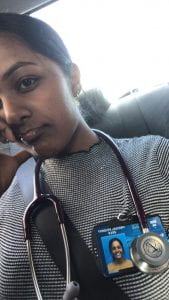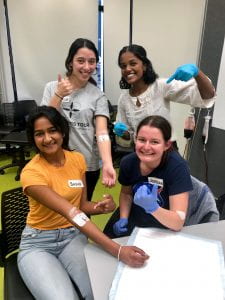Kia ora all!
A long long long absence from The Inside Word, which means I’m back with a BIG update on everything that’s been going on. It’s been a busy busy busy second half of Semester Two – no doubt the busiest I’ve ever been in my entire uni life! It seems that every week a huge assignment is due, tests are looming, and we’re due back at our weekly hospital placements. So let me update you on by far the biggest change that’s happened this semester. We’ve started going into hospitals. Yay! Our placements are only once a week for a few hours though, as we still have our usual lectures and classes to attend as well. But it’s still super exciting, as throughout the second and third years of medical school, we have had limited clinical exposure, with most of our learning done through lectures, tests, and cadaver dissection. It’s almost unreal walking into hospitals, stethoscopes around our necks, learning from consultants and registrars and chatting away with patients. Not our peers. Not simulated actors. Real patients!!! Wow.
There are three hospitals in Auckland (corresponding to the three DHBs) that you can choose from: North Shore Hospital, Auckland City Hospital, and Middlemore Hospital. I chose the amazing Middlemore Hospital as this is my local DHB (which means I can totally either head back to my family home for the weekend or head back to the city where I currently stay!), and I’ve heard great things about the community and teaching at this hospital. Each of us are assigned into ward groups of around 6 medical students each – we visit the same ward every week together. Basically, each of our weekly hospital placements goes a little like this:
- Teaching from the Doctors
We meet our lovely doctors who teach us their insider tips and tricks for examining patients and talking to patients. Every week we focus on a different kind of system examination – eg you can examine and listen to the heart as part of the cardiovascular examination! The doctor runs us through the basics and brushes up our memory on these skills as it’s been some time since we learned them (we’re rusty! haha).
2. Bedside teaching
Next, the doctor takes us to one of their patients. Around their bedside, the doctor performs the examination we just learnt on the patient while pointing out practical tips and abnormal signs (that we’re pretty much seeing for the first time as obviously simulated actor patients and our peers are as fit as a fiddle), as well as inviting each of us in the group to practice one aspect of the examination. I am so grateful for the patients that are so happy to help us learn – I know it must be intimidating to see a whole circle of medical students watching them!
3. Your very own Patient
Finally, the most exciting part! The doctor drops each of us in the group with our very own patient each. We sit down and have a chat with the patient which helps us refine our history-taking skills. It almost always starts off like:
“Hi _____, I’m Sonna Narayanan and I’m a third-year medical student, is it okay if I have a chat with you today about why you’re in the hospital?”. Throughout the next 20-30 mins, we chat with the patient about their presenting complaint, past medical history, family history, medications, social history, and their ideas, concerns and expectations. And of course, in between all of this, we get snippets of their life stories, (really good) advice, and lots of laughs. It’s a really fun experience – which is so different from talking to actors in our clinical skills sessions at University. Actors know what questions we are going to ask and know what to say to us, so it’s almost a little too easy ya know? Whereas real-life patients, you need some tips and tricks to make sure you stay on track and get all the information you need.
Honestly, these hospital placements have helped build my confidence so much, and this is what I’ve heard from a lot of others in my cohort as well! Before our first hospital placement, we were sooo nervous! How was the hospital environment going to be like? How was our doctor/tutor going to be like? How was our first ever patient going to be like? Everything was really unfamiliar but now as we come to the end of our hospital placements (my very last one is tomorrow!), it’s like we’re completely different people. We’re confident with our place in the hospital system as well as talking to patients (we’re no longer worried about dumb things like running out of questions to ask or awkward silences because we’re so much better at it!).
OKAY, and finishing off this blog with something SUPER COOL. We learnt how to cannulate for the very first time! Aka we got to stab each other (with needles). First, we practice on fake plastic model arms which are super realistic – although the blood is just cranberry juice… We find the perfect vein, insert the needle and cannula, and then flush with some salty water (saline) to finish it off.*
*That’s the simple description of what we do, but if you’re interested in seeing exactly what we did with all the little details, here’s a video https://www.youtube.com/watch?v=vE99rZ7JT3Q which is basically what we did. Warning: don’t watch if you’re squeamish about blood!
Anyway, it all sounds super easy, until we actually have to practice on each other! We are taught by the iconic Dr. Magdi (he’s one of our lecturers and runs our Advanced Clinical Skills sessions). Everyone was definitely a little scared of cannulating each other as well as getting cannulated ourselves (ouch). Unlike the practice arms, we don’t have cranberry juice for blood – it’s the real deal. But Dr Magdi is absolutely hilarious and an amazing teacher – and somehow made the scariest experience ever into a totally enjoyable one!? Thankfully, both my cannulation and my partner’s cannulation on myself went smoothly on the very first try! We’re basically experts now, right?
I’ll be back with more blogs sooooon, so let me know if you want to know anything in particular!
Catch ya later,
Sonna xx


I love the idea of IV cannulation, I have seen multiple videos on youtube! Do you guys do this regularly to keep your skills up?
How did you decide you wanted to go into medicine?
Heya Priyanka, I volunteered at the Middlemore Hospital Geriatric Ward on a GATEWAY programme through high school which is when I started thinking about it seriously – before then I kinda wanted to do everything – entrepreneurship, biomedical engineering, etc! I was also lucky enough to be able to talk to others in the medical field (including my parents) 🙂